Beaumont, W. H. (McKechnie Section 1)
Recorded by Jackson (The History of Silhouettes), this artist has often been referred to as 'Beaumont of Cheltenham'. That he did work in Cheltenham at some time is evident from the mention by early writers of several examples inscribed with a Cheltenham address: one of these, of Dr Edward Copleston, was dated 1845. Although he often used a good deal of colour on his later work, there has never been any suggestion that Beaumont worked as a miniature painter, and there seems to be no evidence to identify him with the well known painter of portrait miniatures, John Thomas Barber Beaumont, who took the additional name of Beaumont in 1820. An Anne Beaumont, later Mrs W. Pierce, who may or may not have been connected with the profilist, is said by Mrs Foskett to have exhibited at the Royal Academy and other institutions 1820-36. Graves lists a W. Beaumont who sent in to several art institutions from Rochester six paintings of cattle subjects, exhibited 1832-54. It is possible that this may be the profilist.
Few examples of Beaumont's work are inscribed with an address, but recently a profile of a man, apparently from the late l830s, has come to light. This bears on the back a trade label, obviously intended for use when travelling, which includes the phrase 'Politely announces his intention of sojourning in this town for a few days'. The label also tells us that the artist had been working in Bath and Brighton. He refers to himself simply as 'Mr Beaumont', but his initials are known from his signed work.
284, 290
Even earlier than this are two examples owned by Mr W. E. Fox-Smith, signed merely 'Beaumont' in ink which contained a quantity of iron and which, with age, has rusted and appears brown. These profiles, of a Mr and Mrs Newland Maynard, are stuck to board, which shows, on one example, a watermark of 1832. From the dress of the subjects the profiles appear to have been taken between 1833 and 1835. As another example is dated 1850, Beaumont would appear to have been working over a period of at least seventeen years.
288
Jackson mentions (Dictionary) that 'the late Mrs Andrews of Bournemouth' owned a volume of Beaumont's work. This may have been part of a set of duplicate books such as were kept by other artists producing cut work at the time. Edouart and C. L. Barber among them.
Records of several named portraits exist. The Misses Awdry was owned by Coke. Members of the Rashleigh family (Kilner collection) shows the well known Cornish family. As well as the Copleston portrait already mentioned, Jackson refers to a portrait of C. Fowler of Cheltenham. Since neither any 'stock portraits of royalty nor advertisements by the artist have come to light, there is no evidence that he claimed royal patronage.
287
Beaumont's work of the 1830s does not seem to have been previously recorded. It differs in style from his work of the 1840s, although most of his silhouettes exhibit one unusual technical feature: Beaumont always cut the head of a male sitter separately, and then stuck it in position on the body. Even it there were no natural line of demarcation, such as the edge of a collar, close examination of any of his known silhouettes will bear this out.
Mr W. E. Fox-Smith owns two profiles which. from their appearance, appear to have been executed as early as 1833. These are cut from black paper and embellished with gold. Dr D. S. Patton owns a plain black profile of a woman, seated, and signed W. H. Beaumont': this apparently dates from the late 1830s, I own a profile of a man, of about the same period, which is cut from a dark sepia paper and slightly embellished with gold. The light-coloured waistcoat is left white, with some additional brushwork to indicate its shape. This profile bears Beaumont's 'From Bath and Brighton' trade label.
It is possible that light-coloured papers were not available until the end of the 1830s and, once they were, Beaumont used the paper on which he executed so much of his work of the 1840s.
I shall now turn to Beaumont's better known work, produced in the 1840s. Beaumont has always been best known for his full-length single or group portraits. Their style shows certain idiosyncrasies. One of these is that the profiles are cut not from black or white paper, but from paper which appears to have been sepia. The dull surface of this paper facilitated the painting of additional detail, usually in a darker tone of sepia water-colour.
In order to obliterate the sepia base, parts of the profile, such as collar or cuffs, which had to be shown in white, were rendered in Chinese white and any coloured detail was added in body colour. Most of the detail is added with great care: for example, the binding on the cricket bat on the illustrated profile of a boy. Beaumont also painted flowers exceptionally well.
286
In British Silhouettes Woodiwiss wrote at some length about Beaumont's work. He mentioned in particular a portrait of an aristocratic old lady seated in a chair, the satin cover of which is shown in pink and white stripes. The lady's cap is painted in delicate blue. Woodiwiss had also seen several profiles of men holding a red morocco-bound book; Beaumont also appears to have painted women holding a book. Woodiwiss also mentions a group silhouette of five young women. The furniture in these interior groups is mainly of the early Victorian period, and includes teapots and ornate tea-tables. Carpets are sometimes shown in colour. There seems, however, to be no record of any groups with an exterior background.
I have only been able to see a photograph of the silhouette dated 1850 (mentioned above), and cannot tell from this whether it was executed on a dark or a sepia paper.
To summarize, though Beaumont's work of the 1830s is of only moderate quality, the silhouettes which he produced in the 1840s are among the finest of the period.
Some of Beaumont's full-length silhouettes were signed near the bottom of the card, in the wash base. His signatures vary: 'Beaumont', 'W. H. Beaumont', and 'W. H. Beaumont, fecit, 1850' have all been seen. Only one trade label has been recorded. The text is as follows:
MR. BEAUMONT
From BATH and BRIGHTON, politely announces his intention of sojourning in this town a FEW DAYS. He trusts that his ability as a Profilist is too well known to need exaggeration or puff; and he confidently assures such Persons as may feel disposed to honor him by their patronage, that he is certain of giving the most entire satisfaction.
Profiles from 2s. to 7s.6d
Hours of attendance from 11 till 4.
Ills. 283-290, 633, 642
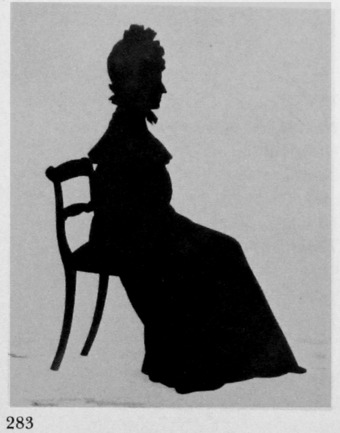
Unknown woman
Cut silhouette
Late 1830s
10 x 7in./254 x 178mm.
Signed by the artist.
D. S. Patton collection
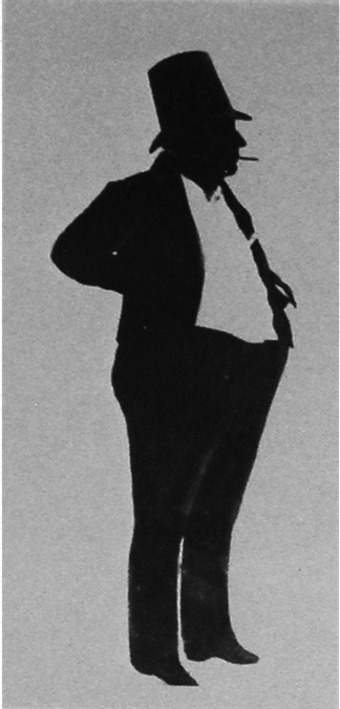
Unknown man
Cut silhouette, painted in dark sepia and touched with gold
Late 1830s
10 x 6 3/8in./254 x 163mm.
Trade label
Frame: black reeded pine with gilt surround.
Author’s collection
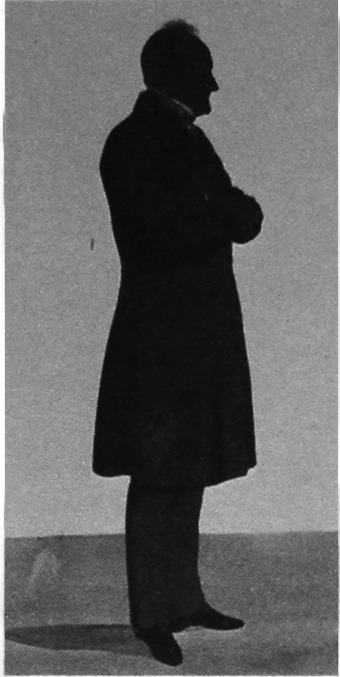
Unknown man
Cut silhouette, painted in sepia, Chinese white and yellow
c. 1838-44
10 x 7in./254 x 178mm.
A typical silhouette by Beaumont.
The figure stands on a wash base; the neckwear is painted in Chinese white.
R. Kilner collection
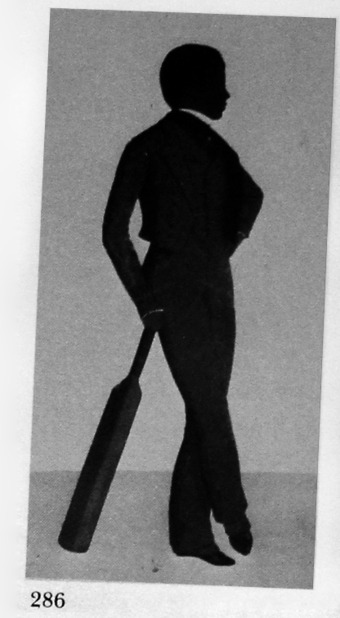
Schoolboy
Cut silhouette, painted in sepia and Chinese white
Probably early 1840s
9¼ x 7½in./235 x 191mm.
Frame: maple
The boy’s shirt collar and cuffs are painted in Chinese white; the pin holding the mailcoach cravat, in yellow. Spatterdashes were sometimes worn during the 1840s for sporting occasions.
Author’s collection
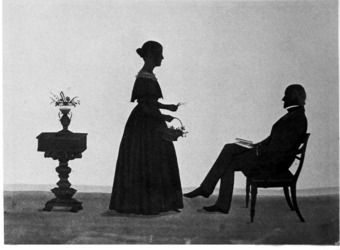
Members of the Rashleigh family
Cut silhouette, painted in sepia and Chinese white
? 1844-48
9 x 15in./229 x 382mm.
Frame: maple, with gilt surround
This silhouette shows two details favoured by Beaumont: the basket of flowers and the book open on the man’s knee.
R. Kilner collection
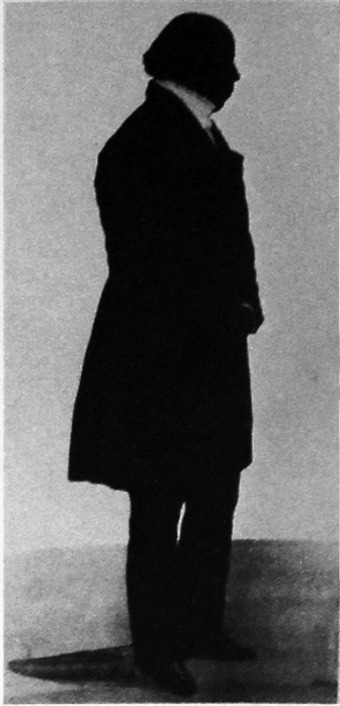
Unknown man
Cut silhouette
1850
Signed ‘W. H. Beaumont fecit, 1850’, this is a late example of the artist’s work.
From the collection of the late J. C. Woodiwiss
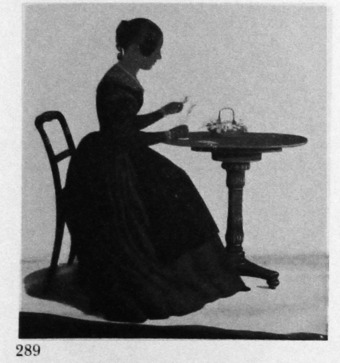
Unknown woman
Cut silhouette, painted in sepia, colour and gold
Early 1850s
10 x 8in./254 x 204mm.
Frame: maple, with gilt surround
Note the sitter’s black apron, often worn at this time with morning clothes. The table s touched with gold, and the flowers are painted in colour.
Crown Copyright, Victoria and Albert Museum, No. P50.1931
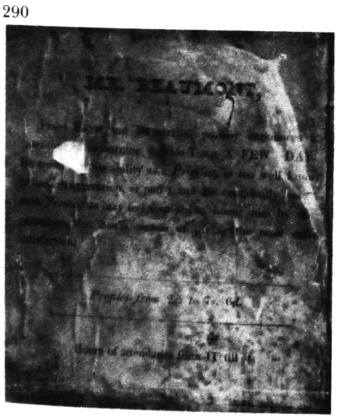
Trade label of W. H. Beaumont, on the reverse of the silhouette illustrated in 284.
Author’s collection
DETAIL
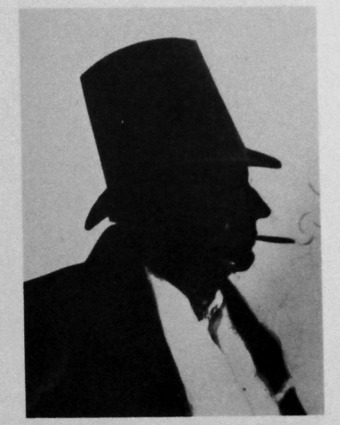
Detail from a silhouette by W. H. Beaumont, taken during the early part of his career. The line between the sitter’s neck (the head is cut separately) and collar is visible. The outline of the waistcoat, cut out from the paper from which the silhouette is cut, is shown by the white card beneath. (284)
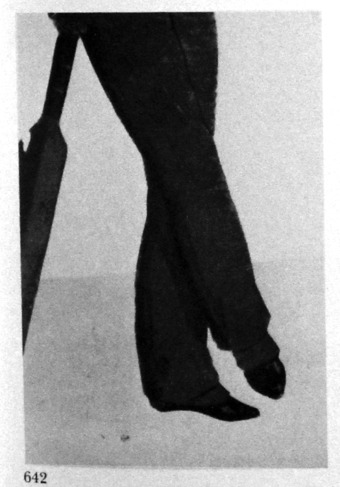
Detail from a silhouette of a boy by H. W. Beaumont, showing the sitter’s legs. Note the clever shading on the footwear and the binding of the cricket bat. The sepia paper has become rubbed over the years. (286)
